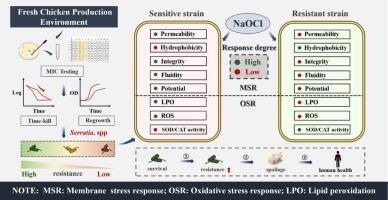表征沙雷氏菌对次氯酸钠的抗性变化:细胞膜和氧化应激反应
IF 8
1区 农林科学
Q1 FOOD SCIENCE & TECHNOLOGY
引用次数: 0
摘要
次氯酸钠(NaOCl)广泛应用于食品加工中控制微生物污染。然而,菌株之间的耐药变异导致灭菌不完全,并构成潜在的食品安全风险,这一点仍然知之甚少。本研究通过MIC测定、时间杀伤曲线评价和生长恢复曲线分析,对从生鸡生产线分离的3株沙雷菌(5S7、AP6和F5)耐药变化的细胞机制进行了研究。结果表明,抗氯能力最强的菌株(5S7)在50 mg/L NaOCl作用下杀菌效率最低,恢复能力最强。同时,经naocl处理后,5S7的膜通透性和流动性较低,膜疏水性较高。流式细胞术(FCM)分析显示,F5对细胞膜完整性的损害最大,其抗性最弱。此外,通过测定NaOCl胁迫下菌株的细胞内活性氧(ROS)水平和抗氧化酶(SOD和CAT)活性,本研究发现抗性最强的菌株5S7的酶活性受损程度较弱。同时,5S7膜的脂质过氧化程度更低。这些发现突出了大肠杆菌对氯的显著耐药变异,为菌株特异性耐药机制提供了关键见解,并指导优化食品安全消毒。本文章由计算机程序翻译,如有差异,请以英文原文为准。

Characterizing variations in resistance of Serratia species to sodium hypochlorite: Cell membrane and oxidative stress responses
Sodium hypochlorite (NaOCl) has widely used in food processing to control microbial contamination. However, the resistant variations among strains leads to incomplete sterilization and poses potential food safety risks, which remains poorly understood. This study investigated the cellular mechanisms underlying the variations in resistance among three Serratia strains (5S7, AP6, and F5) isolated from a fresh chicken production line, which were selected based on MIC determination, time-kill curves evaluation and growth recovery curves analysis. The results demonstrated that the most chlorine-resistant strain (5S7) exhibited the lowest sterilization efficiency and the strongest recovery ability after 50 mg/L NaOCl. Meanwhile, 5S7 showed lower membrane permeability and fluidity, higher membrane hydrophobicity compared with others post-NaOCl treatment. Flow cytometry (FCM) analysis revealed that the F5 (with the weakest resistance) had the highest damage to membrane integrity. Furthermore, based on the measurement of intracellular reactive oxygen species (ROS) levels and the activities of antioxidant enzymes (SOD and CAT) in strains exposed to NaOCl, this study revealed that the enzyme activities in the most resistant strain 5S7 were less impaired compared with those in the less resistant one. Meanwhile, the degree of lipid peroxidation in the 5S7 membrane is even lower. These findings highlight the significant intragenus chlorine-resistant variations, offering key insights into strain-specific resistance mechanisms and guiding optimized disinfection for food safety.
求助全文
通过发布文献求助,成功后即可免费获取论文全文。
去求助
来源期刊

Food Research International
工程技术-食品科技
CiteScore
12.50
自引率
7.40%
发文量
1183
审稿时长
79 days
期刊介绍:
Food Research International serves as a rapid dissemination platform for significant and impactful research in food science, technology, engineering, and nutrition. The journal focuses on publishing novel, high-quality, and high-impact review papers, original research papers, and letters to the editors across various disciplines in the science and technology of food. Additionally, it follows a policy of publishing special issues on topical and emergent subjects in food research or related areas. Selected, peer-reviewed papers from scientific meetings, workshops, and conferences on the science, technology, and engineering of foods are also featured in special issues.
 求助内容:
求助内容: 应助结果提醒方式:
应助结果提醒方式:


